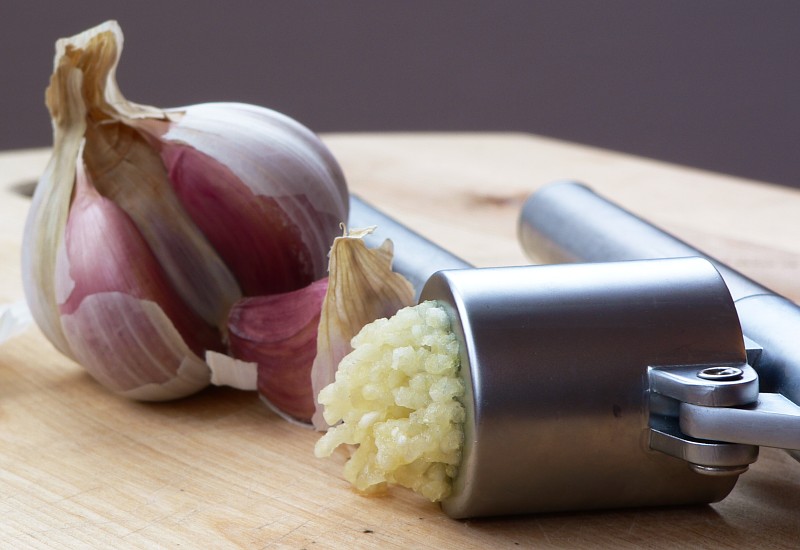Garlic allergy on:
[Wikipedia]
[Google]
[Amazon]
 Garlic allergy or
Garlic allergy or
 Garlic allergy or
Garlic allergy or allergic contact dermatitis
Allergic contact dermatitis (ACD) is a form of contact dermatitis that is the manifestation of an allergic response caused by contact with a substance; the other type being irritant contact dermatitis (ICD).
Although less common than ICD, ACD is ...
to garlic is a common inflammatory skin condition caused by contact with garlic oil or dust. It mostly affects people who cut and handle fresh garlic, such as chefs, and presents on the tips of the thumb, index and middle fingers of the non-dominant hand (which typically hold garlic bulbs during the cutting). The affected fingertips show an asymmetrical pattern of fissure
A fissure is a long, narrow crack opening along the surface of Earth. The term is derived from the Latin word , which means 'cleft' or 'crack'. Fissures emerge in Earth's crust, on ice sheets and glaciers, and on volcanoes.
Ground fissure
...
as well as thickening
A thickening agent or thickener is a substance which can increase the viscosity of a liquid without substantially changing its other properties. Edible thickeners are commonly used to thicken sauces, soups, and puddings without altering thei ...
and shedding of the outer skin layers, which may progress to second- or third-degree burn
A burn is an injury to skin, or other tissues, caused by heat, cold, electricity, chemicals, friction, or ultraviolet radiation (like sunburn). Most burns are due to heat from hot liquids (called scalding), solids, or fire. Burns occur ma ...
of injured skin.
Garlic dermatitis is similar to the tulip
Tulips (''Tulipa'') are a genus of spring-blooming perennial herbaceous bulbiferous geophytes (having bulbs as storage organs). The flowers are usually large, showy and brightly coloured, generally red, pink, yellow, or white (usually in warm ...
dermatitis and is induced by a combined mechanical and chemical action. Whereas the former mechanism acts via skin rubbing which progresses into damage, the major cause of the latter is the chemical diallyl disulfide
Diallyl disulfide (DADS or 4,5-dithia-1,7-octadiene) is an organosulfur compound derived from garlic and a few other genus ''Allium'' plants. Along with diallyl trisulfide and diallyl tetrasulfide, it is one of the principal components of the dist ...
(DADS), together with related compounds allyl propyl disulfide and allicin
Allicin is an organosulfur compound obtained from garlic, a species in the family Alliaceae. It was first isolated and studied in the laboratory by Chester J. Cavallito and John Hays Bailey in 1944. When fresh garlic is chopped or crushed, th ...
. These chemicals occur in oils of plants of the genus ''Allium
''Allium'' is a genus of monocotyledonous flowering plants that includes hundreds of species, including the cultivated onion, garlic, scallion, shallot, leek, and chives. The generic name ''Allium'' is the Latin word for garlic,Gledhill, D ...
'', including garlic, onion
An onion (''Allium cepa'' L., from Latin ''cepa'' meaning "onion"), also known as the bulb onion or common onion, is a vegetable that is the most widely cultivated species of the genus ''Allium''. The shallot is a botanical variety of the onio ...
and leek.
Garlic allergy has been known since at least 1950. It is not limited to hand contact, but can also be induced, with different symptoms, by inhaling garlic dust or ingesting raw garlic, though the latter cases are relatively rare. DADS penetrates through most types of commercial gloves, and thus wearing gloves while handling garlic has proven inefficient against the allergy. Treatment includes avoiding any contact with garlic oil or vapours, as well as medication, such as administering acitretin
Acitretin (trade names Soriatane and Neotigason) is a second-generation retinoid. It is taken orally, and is typically used for psoriasis.
Acitretin is an oral retinoid used in the treatment of severe resistant psoriasis. Because of the potential ...
(25 mg/day, orally) or applying psoralen
Psoralen (also called psoralene) is the parent compound in a family of naturally occurring organic compounds known as the linear furanocoumarins. It is structurally related to coumarin by the addition of a fused furan ring, and may be considered ...
and ultraviolet light to the affected skin area over a period of 12 weeks (PUVA therapy
PUVA (psoralen and UVA) is an ultraviolet light therapy treatment for skin diseases: eczema, psoriasis, graft-versus-host disease, vitiligo, mycosis fungoides, large plaque parapsoriasis, and cutaneous T-cell lymphoma, using the sensitizing ef ...
).
See also
* List of allergiesReferences
{{reflist, 30em Food allergies Immune system disorders